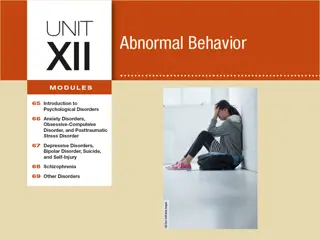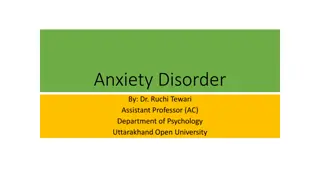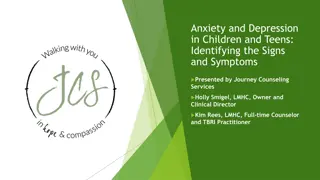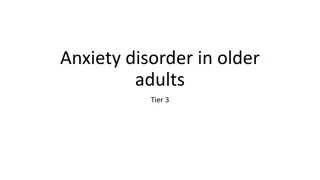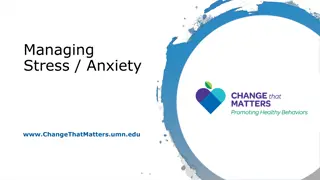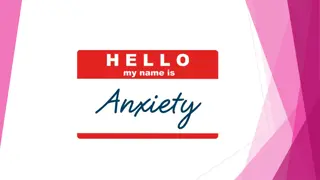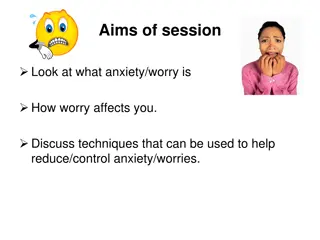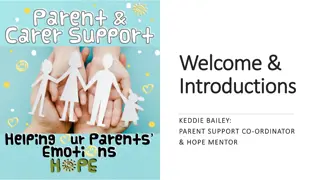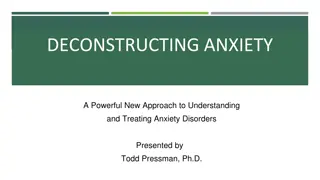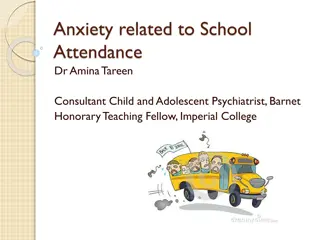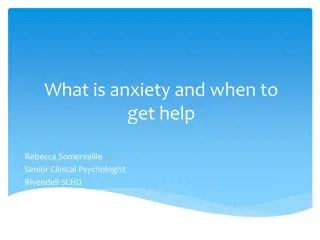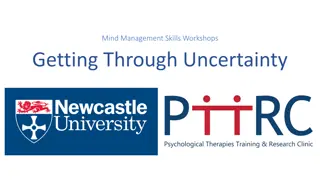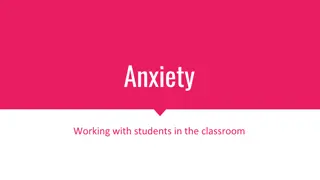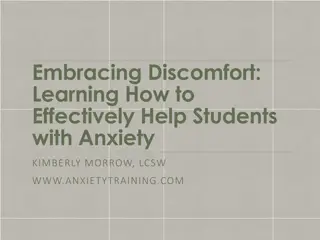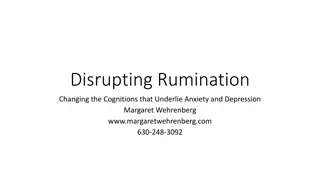Tips for Managing Worry and Anxiety Effectively
Learn to recognize and manage worry effectively to reduce anxiety and stress. By acknowledging your worries, understanding their impact, and taking action, you can regain control and lead a happier, healthier life. Explore the physical reactions associated with worry and differentiate between constructive and destructive worries for better problem-solving. Utilize strategies like the "worry boxes" method to address worries you can impact and find support for those beyond your control.
Download Presentation

Please find below an Image/Link to download the presentation.
The content on the website is provided AS IS for your information and personal use only. It may not be sold, licensed, or shared on other websites without obtaining consent from the author.If you encounter any issues during the download, it is possible that the publisher has removed the file from their server.
You are allowed to download the files provided on this website for personal or commercial use, subject to the condition that they are used lawfully. All files are the property of their respective owners.
The content on the website is provided AS IS for your information and personal use only. It may not be sold, licensed, or shared on other websites without obtaining consent from the author.
E N D
Presentation Transcript
Session 8 Less worry What emotions and behaviours do you associate with worry? Anxiety and stress is actually more optional and more controllable than we first believe. With support and talking, we are able to regain control of anxiety. Once you understand you can have control over your worries, and learn the skills to keep them under control, and are able to regain control when required, you will be happier, healthier. We all would like a balanced life, with the resilience to hold up under pressure and meet challenges head on. So .what is the key?
Name Them, Claim Them, Tame Them So, what is the key? It s actually quite simple .in theory! A way to manage our worries is to get help to recognise them. Then, accept they are there, understand what they do, how they make you feel, and what you can do about it: We will tend to focus on the physical effects of our emotions. How might worry make you feel physically? Remember we are all different in how we react, but more often than not, there are common physical reactions.
Some possible physical reactions might be. Faster breathing Increased temperature and sweaty Tense muscles Feeling shaky and wobbly knees Butterflies in the tummy Stomach Feeling dizzy and/or sick Feeling like they want to cry
Worry is a form of thinking. It is an essential and instinctive emotion that is hard-wired into us humans. Worry occurs when the mind becomes focussed on a particular problem, concern or challenge which is perceived as a threat. Prehistoric people had to worry about being eaten by predators. Those that focussed on the potential threats survived, those that didn t got eaten!
The worry tree on the previous slide shows us that sometimes we can actually do something to reduce the worry, and sometimes like the pandemic we can only do something about changing our perception of the problem. Worry can be either constructive: Worth-it Worry or destructive: Worthless Worry . Worth-it Worry leads to some form of positive action to resolve the problem, concern or challenge. Worthless Worry provides nothing more than a problem. Can you think of any worries you have had recently, and then decide if they were Worth-it Worry, or Worthless worry?
A good way to deal with worries is to imagine 2 boxes in your minds eye. One with worries you can impact like revising for an exam, organising your study time plan how you can improve each of these worries, perhaps even write down your action plan. The second box, is the one with the worries in you can t really change like the pandemic or worries about a love ones health for example. For these, we have to find ways of helping with our worries. This could be talking sharing how you feel, wallow time, or an activity that you know will help like being mindful, the five ways to wellbeing, listening to music ..
Wrestling with your worries There are three main ways of dealing with the demand for a Worry Wrestle: 1. The Scale of 1 10. Where is this issue on a scale of 1 10 (10 being the end of the world ) 2. Uncertainty is a part of life. You cannot be sure your judgement of a worry: worth-it or worthless, is correct. This is like saying to the worry: No, I m not sure but then neither are you. Neither of us have a crystal ball! 3. Let It Be. Let it be means acknowledging and accepting a worry but making no attempt to stop it, complain about it, or enter into the ring with it for a Worry Wrestle. Just letting it be.
Have a think.. What sort of things might a teenager have to worry about generally? What worries might they have in relation to the virus? Can you put them on the 1 10 scale? Which box might you put them in?




